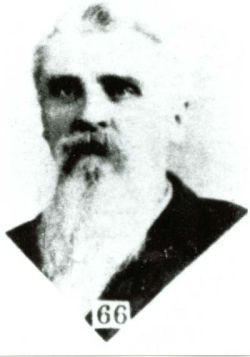Today there is great excitement among members of the Mt. Pisgah Baptist Church, a congregation straddling the Wake and Chatham county lines: many, perhaps most, of the church’s young men in this country church enroll in the Cedar Fork Rifles (also known as the North Carolina Grays).
By the end of the day, the roster of the newly-formed Confederate unit is comprised of numerous men with Baptist affiliations, especially in regards to Mt. Pisgah. Collectively, the stories of these church members paint an interesting portrait of the complexities of a southern, rural congregation in the war years.
Most notable of the enrollees are men who in years leading up to the war had been excommunicated from the church for various reasons.
James Sidney (born 1825) and G. T. Beavers (born 1839), brothers within a middle-class farming family, are two of the young men with Mt. Pisgah connections that enroll in the Cedar Fork Rifles today. Days ago, they had been excommunicated from the church for disrupting church services when news of North Carolina’s secession reached their community. This is not James’ last excommunication: on October 26, 1861 he is excommunicated “for opposing White and coloured equality in the church,” perhaps a reference to the fact that his congregation (like many others in the South at this time) treated blacks and whites with some measure of equality regarding matters of discipline within the church. James dies from typhoid fever on January 3, 1862 at Camp Fisher, Virginia.
Another prominent Mt. Pisgah family is the Williams clan. Several Williams’ family members also enroll in the army today, including John Ferdinand Williams (born 1830), who has had his own troubles with the church. In February John had been accosted by church elders who were conducting an investigation against him for playing cards. But when the charges had been made, John retorted that he would not stop playing cards unless other members stopped drinking alcohol and refusing to contribute fairly to the pastor’s salary. Unappreciative of John’s reply, the church had excommunicated him in March. Yet John survives the war, and is later buried at Mt. Pisgah’s cemetery.
John’s defiance may in part be attributed to the prior excommunication of his younger brother, Cannon Lunsford (born 1835), in October 1860. Regardless, by enrolling in the army, the two brothers may have envisioned a new start of sorts. And while both brothers survive the war, cousin Jackson L. Williams, in good standing with the church and also enrolling today, dies of disease mere months later at Camp Jones, Virginia, on September 13.
Lemuel Holdier, age 22, also enrolls in the army today. Despite confessing to and asking for forgiveness from the church, Holdier had been excommunicated from Mt. Pisgah in July 1858 for “intemperance.” Holdier is wounded at Sharpsburg, Maryland on September 17, 1862, then captured at Waynesboro, Pennsylvania on July 7, 1863. Confined at Point Lookout, Maryland, he dies March 2, 1864, and is buried in Maryland.
Yet another former member of Mt. Pisgah, Joseph Lassiter, age 31, enrolls today. His church membership had been revoked in July 1856 for “drinking too much at times.” Lassiter dies on September 14 from “fever.”
At least seventeen men associated with Mt. Pisgah Baptist (either expressly identified as members, former members, and/or buried in the church cemetery) ultimately enroll in the Cedar Fork Rifles, some in good standing, and others recipients of disciplinary actions. Nearly as many enrollees are associated with other Baptist churches in the area, such as William Marion Lowe (pictured), who survives the war and lives until 1912.
The story of the Mt. Pisgah Baptist congregation in the early weeks of war, in short, is that of a congregation of devoted Confederate menfolk, many of whom in years prior had run afoul of the church’s moral code prohibiting drunkenness (alcohol per se, however, was not necessarily disallowed) and card-playing, among other infractions. As in many other rural communities of the South, local congregations serve as upholders of community standards, supply many soldiers for the Confederacy, and as the war progresses, are comprised of grieving families in the wake of the deaths of husbands, brothers and sons.
Sources: James S. and G. T. excommunication, “Life in the Army: Letters of the Beavers Boys,” Duke University Library Special Collections (link) and (link) – the date of James’ excommunication over the issue of white/black equality is contradictory in the records noted herein, but 1861 seems to be the more likely date; Roster of Cedar Fork Rifles (link); William Lowe photograph (link)



